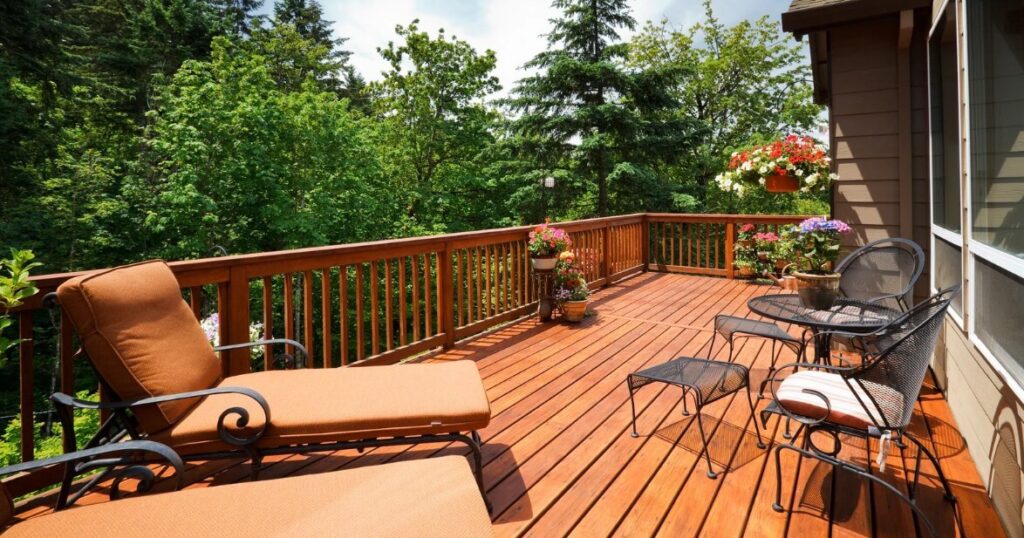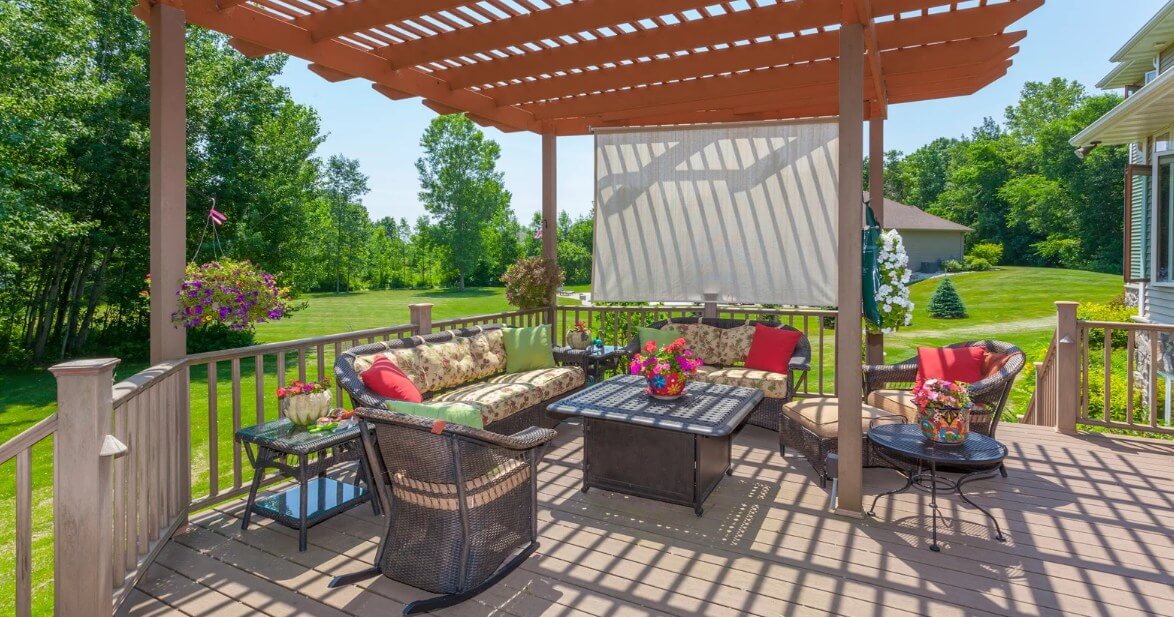Outdoor living spaces have become an essential feature in Canadian homes, offering a place to relax, entertain, and enjoy the natural beauty of the surrounding environment. These spaces, whether it’s a cozy patio or a stylish deck, can significantly enhance not only the functionality of your home but also its overall value.
A well-designed outdoor area provides countless benefits. It creates a seamless connection between indoor and outdoor living, expands your usable space, and offers a retreat where you can unwind or host gatherings with friends and family. These spaces are more than just an addition to their property—they are an extension of their lifestyle, tailored to fit their needs and the changing seasons.
In this blog, we’ll explore the key elements of designing a patio or deck, tips for maximizing comfort and appeal, and how to choose the best materials for durability and style. Whether you’re starting from scratch or upgrading an existing space, this guide will help you create the perfect outdoor living area for your home.
Understanding the Basics of Patios and Decks
When planning outdoor spaces, it’s important to understand the differences between patios and decks. Both are great options for enhancing your outdoor living area, but each has unique features, materials, and benefits that make them suited for different needs and locations. Let’s break down the basics.
What is a Patio?

A patio is a flat, ground-level outdoor space, usually attached to the house or located within the backyard. Patios are versatile and can be designed to fit a variety of styles and purposes.
Typical Materials
Patios are typically paved surfaces and are built directly onto the ground. Common materials include concrete, stone, pavers, brick, or gravel. These materials offer durability and can be customized with colours, patterns, or finishes to complement your home’s style.
Common Features of Patios
Patios often include features like built-in seating, fire pits, outdoor kitchens, or landscaping elements that help create a cozy, welcoming atmosphere. They can be left open or shaded with pergolas, umbrellas, or retractable awnings for comfort.
Suitable Locations for Patios
Since patios are ground-level, they work best on flat terrain. They are ideal for backyards, courtyards, or areas near gardens. If built on uneven ground, additional work such as grading or retaining walls may be required. Patios are great for dining areas, entertaining spaces, or relaxing spots surrounded by nature.
What is a Deck?

A deck is a raised outdoor platform that extends from the house or stands as a freestanding structure. Decks provide elevation, making them a great choice for homes with sloped yards or areas with scenic views.
Typical Materials
Decks are typically made of wood or composite materials. Popular woods include cedar, redwood, and pressure-treated lumber, while composite materials offer a low-maintenance alternative that mimics the look of real wood. Composite and PVC decking are also resistant to rot, insects, and weather damage, making them a durable option.
Common Features of Decks
Decks often feature railings for safety, especially if they are built at higher elevations. Many decks also include built-in planters, seating, or even outdoor lighting to enhance their usability. They’re great for hosting barbecues, enjoying a morning coffee, or creating an outdoor lounge space.
Ideal Locations and Elevation Considerations
Decks are well-suited for homes with uneven or sloping yards, as they can be elevated to create a level surface. They are also a great option for areas where you want to maximize a view, such as overlooking a garden, pool, or scenic landscape. The height of the deck often determines whether permits or additional safety measures, like reinforced railings or stairs, are required.
By understanding the differences between patios and decks, you can choose the outdoor space that best suits your home, lifestyle, and personal preferences. Both options can enhance your outdoor living experience and add value to your property.
Comparing Patios and Decks
When deciding between a patio and a deck, cost is often a significant factor. Patios tend to be more affordable upfront, as they are typically built at ground level and don’t require the structural support that decks do. The typical cost of building a patio can vary based on materials like concrete, brick, or stone, but it is generally lower than the cost of a deck, which often requires wood or composite materials and added labour for elevation.
Long-term maintenance costs also differ. Patios are often easier and cheaper to maintain, as they are less prone to issues like rot or warping. Decks, especially those made of wood, may require regular staining, sealing, or even replacing boards to maintain their appearance and durability.
Durability and Climate Considerations
Canadian weather can be challenging for outdoor structures, making durability a key consideration. Patios, made of materials like concrete, stone, or pavers, are naturally resistant to extreme weather conditions. They don’t warp in the heat or rot in the rain, but they can crack due to freeze-thaw cycles in colder climates. Regular sealing can help minimize this risk.
Decks, on the other hand, need to be built with climate-resistant materials to withstand Canadian weather. Wood decks require protective treatments to avoid rot, warping, and insect damage, while composite decks offer better resistance to moisture, fading, and temperature changes. Choosing the right materials is crucial; for example, pressure-treated wood and composite boards are excellent options for withstanding moisture and extreme temperatures.
Aesthetic and Functional Differences
The aesthetic appeal of patios versus decks depends largely on personal preference and the overall style of your home. Patios are ideal for creating a sleek, modern look with their clean lines and integration into the landscape. They work well with rustic or minimalist home styles, especially when paired with materials like natural stone or stamped concrete.
Decks, however, bring a sense of elevation and openness, making them great for homes with scenic views or uneven terrain. They can add charm to traditional or rustic homes with wood finishes or provide a contemporary feel with composite materials and sleek railings.
Functionality is another critical difference. Patios are excellent for activities like grilling, dining, or lounging at ground level. They often blend seamlessly into gardens or yards, creating a natural flow between indoor and outdoor spaces. Decks, on the other hand, offer more versatility for homes on slopes or with limited outdoor space. They provide a perfect spot for entertaining, relaxing, or even adding features like built-in seating, pergolas, or hot tubs.
Whether you choose a patio or a deck, understanding these factors will help you make the best decision for your home, lifestyle, and budget.
Design Options for Patios and Decks
When designing your outdoor space, patios and decks offer endless possibilities to create a relaxing and stylish retreat. Whether you prefer a cozy nook or a lively entertaining area, here are some trendy design ideas to inspire your next project.
Popular Patio Designs
- Simple and Minimalist Layouts: Clean lines and uncluttered spaces are a go-to for creating a modern and elegant patio. Opt for neutral colours, sleek furniture, and well-defined areas to keep the design cohesive and functional.
- Incorporating Natural Elements: Bring the outdoors to life by using natural materials like stone, wood, and greenery. Stone pathways, lush plants, or a vertical garden can add texture and charm, helping your patio blend seamlessly with its surroundings.
- Creative Features: Make your patio stand out with unique additions such as fire pits for cozy evenings, built-in seating for practicality, or water features like fountains or small ponds to add a soothing ambiance. String lights or lanterns can enhance the atmosphere, making your patio perfect for any occasion.
Trendy Deck Designs
- Multi-Level and Elevated Decks: Create depth and dimension with multi-level decks that divide your outdoor space into functional zones. Elevated decks offer great views and are ideal for sloped yards or small spaces. You can designate areas for dining, lounging, or grilling to make the most of your deck.
- Adding Railings, Pergolas, or Canopies: Enhance your deck’s design with stylish railings made of glass, metal, or wood. Pergolas can provide shade while adding a sophisticated aesthetic, and canopies or retractable awnings make it easy to enjoy your deck in any weather.
- Innovations in Composite Decking and Eco-Friendly Materials: Modern composite decking materials offer durability, low maintenance, and a wide range of colours and textures. Many homeowners are now opting for eco-friendly options made from recycled materials, combining sustainability with stunning design.
With these design ideas, you can create an outdoor space that fits your style and meets your needs, making your patio or deck the perfect extension of your home. Whether you prefer a natural vibe, a sleek modern look, or a mix of both, the possibilities are endless!
Practical Considerations Before Building Patios and Decks
Local Regulations and Permits
Before starting any construction on your patio or deck, it’s crucial to understand the local regulations and permitting requirements in Alberta. Municipal bylaws often dictate what is allowed in terms of size, height, and proximity to property lines. Skipping this step can lead to costly fines or even being required to tear down structures that don’t comply. Research your local zoning rules and consult with your municipal office to determine what permits you’ll need. Hiring a professional contractor familiar with Alberta’s building codes can help ensure your project meets all legal requirements. Additionally, keep in mind any neighbourhood-specific restrictions and guidelines that may impact your design choices.
Maintenance Demands
Building an outdoor space is an investment, and maintaining it properly will ensure it stays in excellent condition for years to come. Patios often require routine upkeep, such as sweeping away debris, power washing, and sealing the surface to protect it from weather damage. Depending on the material—whether concrete, stone, or pavers—you may also need to address issues like cracks or shifting caused by seasonal changes.
Decks, on the other hand, demand a different kind of maintenance. Wooden decks may require staining and sealing every few years to prevent fading, warping, or moisture damage. Boards may need to be replaced over time, particularly in high-traffic areas. If you opt for composite decking, you’ll benefit from lower maintenance requirements, though occasional cleaning is still necessary.
Professional vs. DIY
When it comes to building or maintaining a patio or deck, deciding between hiring a professional and taking the DIY route is an important consideration. Hiring a professional ensures the work is completed efficiently and with expert craftsmanship. Professionals bring specialized tools, experience, and knowledge to handle complex designs or challenging structural requirements. Additionally, their expertise can help avoid costly mistakes and ensure the project meets safety standards.
On the other hand, a DIY approach can be more cost-effective and personally rewarding. It allows you to control every aspect of the project, from the design to material selection, and the sense of accomplishment from completing the work yourself can be highly satisfying. However, DIY projects require significant time, effort, and a certain level of skill, particularly for larger or more intricate builds. For those who are unsure of their abilities, starting with smaller upgrades or repairs may be a good way to build confidence and experience. Ultimately, the choice between professional and DIY depends on your budget, schedule, and comfort level with hands-on work.
Why Hire Professionals for Your Patios and Decks?
While many maintenance tasks can be handled on your own, hiring professionals for certain aspects of your patio or deck care can make a big difference. Experts bring the knowledge and experience needed to assess and address potential issues that might go unnoticed by the untrained eye. For example, they can identify structural damage, treat wood properly, or recommend advanced cleaning techniques for composite materials. Additionally, professionals have access to tools and materials that allow them to complete jobs efficiently and to a higher standard, saving you both time and effort. Whether you need a thorough inspection, repairs, or a deep clean, investing in professional support ensures that your outdoor space remains safe, functional, and visually appealing for years to come.
Conclusion
Creating the perfect outdoor living space is an investment in both your home’s value and your quality of life. Whether you’re envisioning a patio, a deck, or a combination of both, the key is choosing a design that fits your unique vision while enhancing how you enjoy your outdoor areas. With the right planning, expert advice, and professional assistance, you can transform your outdoor space into a functional and stunning retreat, perfect for relaxing, entertaining, or simply enjoying nature. The possibilities are endless, and your dream outdoor space is closer than you think.
Looking for expert guidance to bring your project to life? Reach out to GPS Alberta today! Our team offers professional advice, customized solutions, and detailed quotes tailored to your requirements. Whether you’re just starting or looking to take your project to the next level, we’re here to help every step of the way. Contact us now and let’s make it happen!


